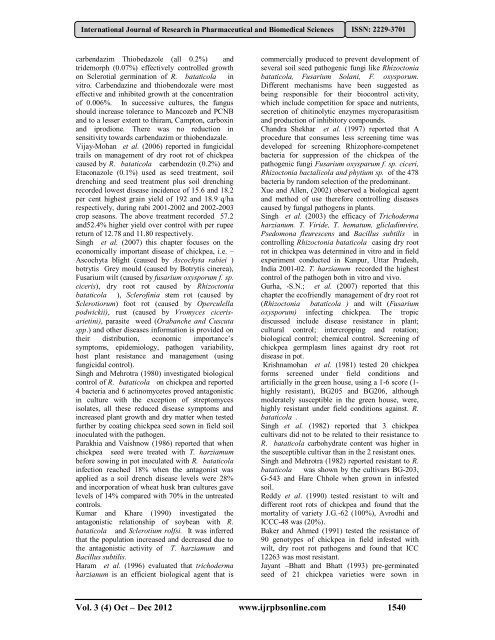Dry root Rot Caused by Rhizoctonia bataticola - International ...
Dry root Rot Caused by Rhizoctonia bataticola - International ...
Dry root Rot Caused by Rhizoctonia bataticola - International ...
Create successful ePaper yourself
Turn your PDF publications into a flip-book with our unique Google optimized e-Paper software.
<strong>International</strong> Journal of Research in Pharmaceutical and Biomedical Sciences ISSN: 2229-3701carbendazim Thiobedazole (all 0.2%) andtridemorph (0.07%) effectively controlled growthon Sclerotial germination of R. <strong>bataticola</strong> invitro. Carbendazine and thiobendozale were mosteffective and inhibited growth at the concentrationof 0.006%. In successive cultures, the fungusshould increase tolerance to Mancozeb and PCNBand to a lesser extent to thiram, Campton, carboxinand iprodione. There was no reduction insensitivity towards carbendazim or thiobendazale.Vijay-Mohan et al. (2006) reported in fungicidaltrails on management of dry <strong>root</strong> rot of chickpeacaused <strong>by</strong> R. <strong>bataticola</strong> carbendozin (0.2%) andEtaconazole (0.1%) used as seed treatment, soildrenching and seed treatment plus soil drenchingrecorded lowest disease incidence of 15.6 and 18.2per cent highest grain yield of 192 and 18.9 q/harespectively, during rabi 2001-2002 and 2002-2003crop seasons. The above treatment recorded 57.2and52.4% higher yield over control with per rupeereturn of 12.78 and 11.80 respectively.Singh et al. (2007) this chapter focuses on theeconomically important disease of chickpea, i.e. –Ascochyta blight (caused <strong>by</strong> Ascochyta rabiei )botrytis Grey mould (caused <strong>by</strong> Botrytis cinerea),Fusarium wilt (caused <strong>by</strong> fusarium oxysporum f. sp.ciceris), dry <strong>root</strong> rot caused <strong>by</strong> <strong>Rhizoctonia</strong><strong>bataticola</strong> ), Sclerofinia stem rot (caused <strong>by</strong>Sclerotiorum) foot rot (caused <strong>by</strong> Operculellapodwickii), rust (caused <strong>by</strong> Vromyces cicerisarietini),parasite weed (Orabanche and Cuscutaspp.) and other diseases information is provided ontheir distribution, economic importance’ssymptoms, epidemiology, pathogen variability,host plant resistance and management (usingfungicidal control).Singh and Mehrotra (1980) investigated biologicalcontrol of R. <strong>bataticola</strong> on chickpea and reported4 bacteria and 6 actinomycetes proved antagonisticin culture with the exception of streptomycesisolates, all these reduced disease symptoms andincreased plant growth and dry matter when testedfurther <strong>by</strong> coating chickpea seed sown in field soilinoculated with the pathogen.Parakhia and Vaishnow (1986) reported that whenchickpea seed were treated with T. harziamumbefore sowing in pot inoculated with R. <strong>bataticola</strong>infection reached 18% when the antagonist wasapplied as a soil drench disease levels were 28%and incorporation of wheat husk bran cultures gavelevels of 14% compared with 70% in the untreatedcontrols.Kumar and Khare (1990) investigated theantagonistic relationship of soybean with R.<strong>bataticola</strong> and Sclerotium rolfsi. It was inferredthat the population increased and decreased due tothe antagonistic activity of T. harziamum andBacillus subtilis.Haram et al. (1996) evaluated that trichodermaharzianum is an efficient biological agent that iscommercially produced to prevent development ofseveral soil seed pathogenic fungi like <strong>Rhizoctonia</strong><strong>bataticola</strong>, Fusarium Solani, F. oxysporum.Different mechanisms have been suggested asbeing responsible for their biocontrol activity,which include competition for space and nutrients,secretion of chitinolytic enzymes mycroparasitismand production of inhibitory compounds.Chandra Shekhar et al. (1997) reported that Aprocedure that consumes less screening time wasdeveloped for screening Rhizophore-competenetbacteria for suppression of the chickpea of thepathogenic fungi Fusarium oxysparum f. sp. ciceri,<strong>Rhizoctonia</strong> bactalicola and phytium sp. of the 478bacteria <strong>by</strong> random selection of the predominant.Xue and Allen, (2002) observed a biological agentand method of use therefore controlling diseasescaused <strong>by</strong> fungal pathogens in plants.Singh et al. (2003) the efficacy of Trichodermaharzianum. T. Viride, T. hematum, glicladimvire,Psedomona fleurescens and Bacillus subtilis incontrolling <strong>Rhizoctonia</strong> <strong>bataticola</strong> casing dry <strong>root</strong>rot in chickpea was determined in vitro and in fieldexperiment conducted in Kanpur, Uttar Pradesh,India 2001-02. T. harzianum recorded the highestcontrol of the pathogen both in vitro and vivo.Gurha, -S.N.; et al. (2007) reported that thischapter the ecofriendly management of dry <strong>root</strong> rot(<strong>Rhizoctonia</strong> <strong>bataticola</strong> ) and wilt (Fusariumoxysporum) infecting chickpea. The tropicdiscussed include disease resistance in plant;cultural control; intercropping and rotation;biological control; chemical control. Screening ofchickpea germplasm lines against dry <strong>root</strong> rotdisease in pot.Krishnamohan et al. (1981) tested 20 chickpeaforms screened under field conditions andartificially in the green house, using a 1-6 score (1-highly resistant), BG205 and BG206, althoughmoderately susceptible in the green house, were,highly resistant under field conditions against. R.<strong>bataticola</strong> .Singh et al. (1982) reported that 3 chickpeacultivars did not to be related to their resistance toR. <strong>bataticola</strong> carbohydrate content was higher inthe susceptible cultivar than in the 2 resistant ones.Singh and Mehrotra (1982) reported resistant to R.<strong>bataticola</strong> was shown <strong>by</strong> the cultivars BG-203,G-543 and Hare Chhole when grown in infestedsoil.Reddy et al. (1990) tested resistant to wilt anddifferent <strong>root</strong> rots of chickpea and found that themortality of variety J.G.-62 (100%), Avrodhi andICCC-48 was (20%).Baker and Ahmed (1991) tested the resistance of90 genotypes of chickpea in field infested withwilt, dry <strong>root</strong> rot pathogens and found that ICC12263 was most resistant.Jayant –Bhatt and Bhatt (1993) pre-germinatedseed of 21 chickpea varieties were sown inVol. 3 (4) Oct – Dec 2012 www.ijrpbsonline.com 1540
















